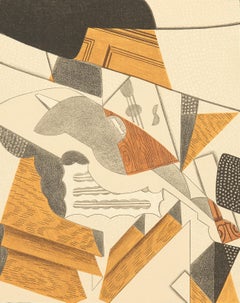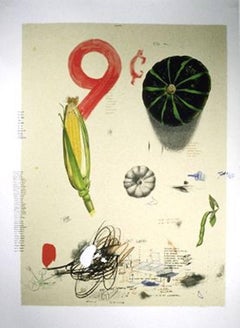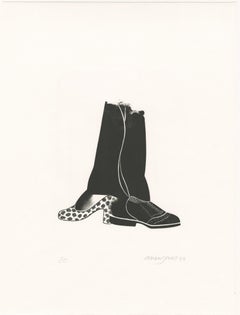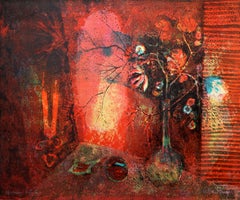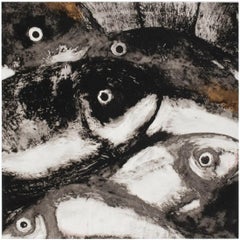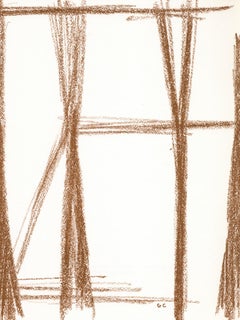Lithograph Still-life Prints
to
566
664
222
332
147
36
Overall Width
to
Overall Height
to
394
137
92
82
52
42
41
35
15
12
10
2
1
36
27
27
26
19
3
111
1,206
81
16
9
25
8
74
193
232
208
202
47
935
438
24
252
227
189
165
126
124
87
80
72
70
51
50
44
42
40
39
37
35
32
29
1,401
975
603
592
394
122
280
978
232
Medium: Lithograph
Juan Gris, Violin, from Au Soleil du Plafond, 1955 (after)
By Juan Gris
Located in Southampton, NY
This exquisite lithograph after Juan Gris (1887–1927), titled Violin (Violin), from the folio Au Soleil du Plafond (In the Sunlight of the Ceiling), originates from the 1955 edition ...
Category
1950s Cubist Lithograph Still-life Prints
Materials
Lithograph
$1,996 Sale Price
20% Off
Three Sisters
By Will Mentor
Located in New York, NY
Will Mentor received his BFA at the Rhode Island School of Design and arrived on the New York art scene in the early 1980’s, gaining instant success for what critics referred to as h...
Category
1990s Contemporary Lithograph Still-life Prints
Materials
Lithograph
$720 Sale Price
40% Off
Shoe Box (C)
By Allen Jones
Located in Fairlawn, OH
Shoe Box (C)
From: Shoe Box-Exotic (Sculpture and seven original lithographs)
Signed, dated, titled and numbered in pencil (see photos)
Lithograph printed on ...
Category
1960s Pop Art Lithograph Still-life Prints
Materials
Lithograph
Still Life in Red, Abstract Lithograph by Lebadang
By Hoi Lebadang
Located in Long Island City, NY
Still Life in Red
Lebadang, Vietnamese (1922–2015)
Lithograph, signed and numbered in pencil
Edition of E.A.
Size: 19.5 x 25.5 in. (49.53 x 64.77 cm)
Category
1970s Modern Lithograph Still-life Prints
Materials
Lithograph
Donald Sultan 'Fish' (From Fruit and Flowers), Limited Edition, Signed Print
Located in San Rafael, CA
Donald Sultan (American, b. 1951)
"Fish (From Fruit and Flowers Portfolio)" 1990
Screenprint in colors on Arches 88 paper
Pencil initialed, titled, and dated left of image
Edition 61...
Category
1990s Contemporary Lithograph Still-life Prints
Materials
Lithograph
Cavallon, Sans titre, In Memory of My Feelings (after)
By Giorgio Cavallon
Located in Southampton, NY
Lithograph on vélin Mohawk Superfine Smooth paper. Paper Size: 11.937 x 8.96 inches. Inscription: Signed in the plate and unnumbered, as issued. Notes: From the folio, In Memory of M...
Category
1960s Abstract Expressionist Lithograph Still-life Prints
Materials
Lithograph
$716 Sale Price
20% Off
Escobar, Sans titre, In Memory of My Feelings (after)
Located in Southampton, NY
Lithograph on vélin Mohawk Superfine Smooth paper. Paper Size: 11.937 x 11.937 inches, with centerfold, as issued. Inscription: Unsigned and unnumbered, as issued. Notes: From the fo...
Category
1960s Pop Art Lithograph Still-life Prints
Materials
Lithograph
$1,596 Sale Price
20% Off
Freilicher, Sans titre, In Memory of My Feelings (after)
Located in Southampton, NY
Lithograph on vélin Mohawk Superfine Smooth paper. Paper Size: 11.937 x 11.937 inches, with centerfold, as issued. Inscription: Signed in the plate and unnumbered, as issued. Notes: ...
Category
1960s Academic Lithograph Still-life Prints
Materials
Lithograph
$716 Sale Price
20% Off
Blaine, Sans titre, In Memory of My Feelings (after)
By Nell Blaine
Located in Southampton, NY
Lithograph on vélin Mohawk Superfine Smooth paper. Paper Size: 11.937 x 11.937 inches, with centerfold, as issued. Inscription: Unsigned and unnumbered, as issued. Notes: From the fo...
Category
1960s Academic Lithograph Still-life Prints
Materials
Lithograph
$716 Sale Price
20% Off
D'Arcangelo, Sans titre, In Memory of My Feelings (after)
Located in Southampton, NY
Lithograph on vélin Mohawk Superfine Smooth paper. Paper Size: 11.937 x 11.937 inches, with centerfold, as issued. Inscription: Unsigned and unnumbered, as issued. Notes: From the fo...
Category
1960s Pop Art Lithograph Still-life Prints
Materials
Lithograph
$716 Sale Price
20% Off
Hanging Mistletoe (Loranthus pendulus), antique botanical plant lithograph
Located in Melbourne, Victoria
'Hanging Mistletoe (Loranthus pendulus)'
Colour lithograph, 1909.
Category
Early 20th Century Naturalistic Lithograph Still-life Prints
Materials
Lithograph
After Jonas Wood Jungle Kitchen Exhibit Poster Interiors & Landscapes Kordansky
By Jonas Wood
Located in Draper, UT
Stamped on the Verso of the print and in Mint Condition. From the David Kordansky Gallery show in 2017. Very rare poster that has been stored flat since purchase. One of his most ...
Category
2010s Contemporary Lithograph Still-life Prints
Materials
Lithograph
Tuscan Bunch, 1987 - Still Life Print of Flowers in a Vase, Neutral with Red
By André Bicât
Located in Kingsclere, GB
Born in Essex to French and Anglo-Irish parents, André Bicât was a painter, printmaker and influential teacher.
From 1966-74 he worked as a tutor in the Printmaking Departments at...
Category
20th Century Lithograph Still-life Prints
Materials
Lithograph
Furze (Ulex Europaeus), antique botanical lithograph
Located in Melbourne, Victoria
'Furze (Ulex Europaeus, Linne)'
Colour lithograph, 1909.
Category
Early 20th Century Naturalistic Lithograph Still-life Prints
Materials
Lithograph
Margaritas
Located in New York, NY
“Margaritas” is a lithograph created by Emilio Sanchez in 1997. This impression is signed, titled, and inscribed "12/50" - the 12 print from an edition of 50 impressions. The printed image size is 12.50 x 14.25 inches (31.3 x 35.7 cm) and the paper size is 18 x 20.13 inches - all four paper edges are decked adding a nice option when framed. This print came to us directly from the Emilio Sanchez Estate (circular estate stamp is on verso). Stamped on verso "Estate of Emilio Sanchez."
“Best known for his architectural paintings and lithographs, Emilio Sanchez (1921-1999) explored the effects of light and shadow to emphasize the abstract geometry of his subjects. His artwork encompasses his Cuban heritage...
Category
Late 20th Century Contemporary Lithograph Still-life Prints
Materials
Lithograph
Growing an Onion
By Will Mentor
Located in New York, NY
Will Mentor received his BFA at the Rhode Island School of Design and arrived on the New York art scene in the early 1980’s, gaining instant success for what critics referred to as h...
Category
1990s Contemporary Lithograph Still-life Prints
Materials
Lithograph
$960 Sale Price
20% Off
1971 Tamarind Print Landscape Lithograph Paul Sarkisian Photo Realist Americana
Located in Surfside, FL
Paul Sarkisian (1928-)
1971 Brown Landscape Lithograph Silkscreen Print
on calendred BFK Rives fine art paper. small edition of 15 from Tamarind print workshop with their blindstamp....
Category
1970s Lithograph Still-life Prints
Materials
Lithograph
Cape and Islands Chamber Music Festival (Jade Plant Still Life) Poster (Signed)
By Jim Dine
Located in Saint Augustine, FL
Artist: (after) Jim Dine (American, 1935-)
Title: "Cape and Islands Chamber Music Festival (Jade Plant Still Life)"
Series: Cape and Islands Chamber Music Festival Posters (First sea...
Category
1980s Contemporary Lithograph Still-life Prints
Materials
Lithograph, Offset
Morchella Conica, Leuba antique mushroom fungi morel chromolithograph print
Located in Melbourne, Victoria
'Morchella Conica'
Antique Swiss mushroom / fungi chromolithograph, lithographed by H Furrer after Fritz Leuba. The print is titled with the scientific name...
Category
Late 19th Century Naturalistic Lithograph Still-life Prints
Materials
Lithograph
Dang (Hoi) Lebadang Floral Still Life Lithograph C.1970
By Hoi Lebadang
Located in San Francisco, CA
Dang (Hoi) Lebadang Floral Still Life Lithograph C.1970
Lithograph dimensions 7" wide x 7.75" high
Frame dimensions 17" wide x 19" high (the frame has no glass)
Pencil signed and ...
Category
Mid-20th Century Lithograph Still-life Prints
Materials
Lithograph
Violent Violin Concerto Hand Signed Lithograph Silkscreen
By Arman
Located in Surfside, FL
Arman (November 17, 1928 – October 22, 2005) was a French-born American artist. Born Armand Fernandez in Nice, France, Arman was a painter who moved from using objects for the ink or...
Category
1970s Abstract Lithograph Still-life Prints
Materials
Lithograph
Fall Apples, Lithograph by Richard Karwoski
Located in Long Island City, NY
Artist: Richard Karwoski, American (1938 - 1993)
Title: Fall Apples
Year: 1980
Medium: Lithograph, signed and numbered in pencil
Edition: 300, AP 40
Paper Size: 22 in. x 29.5 in. (55...
Category
1980s Contemporary Lithograph Still-life Prints
Materials
Lithograph
Marilyn's Flowers II, Pop Art Lithograph by Peter Max
By Peter Max
Located in Long Island City, NY
Artist: Peter Max, German/American (1937 - )
Title: Marilyn's Flowers II
Year: 1981
Medium: Lithograph, signed and numbered in pencil
Edition: 165
Image Size: 19 x 23.5 inches
Category
1980s Pop Art Lithograph Still-life Prints
Materials
Lithograph
1971 Tamarind Workshop Satchel Lithograph Paul Sarkisian Photo Realist Americana
Located in Surfside, FL
Paul Sarkisian (1928-)
1971 Blue Satchel or Mailbag Lithograph Silkscreen Print
on calendred BFK Rives fine art paper. small edition of 12 from Tamarind print workshop with their bli...
Category
1970s American Modern Lithograph Still-life Prints
Materials
Lithograph
Red Apple, Realist Lithograph
Located in Long Island City, NY
Artist: A. Lester Gaba, American (1907 - 1987)
Title: Red Apple
Year: circa 1980
Medium: Lithograph, signed and numbered in pencil
Edition PP 8/10
Size: 29.5 x 26 in. (74.93 x 66.04...
Category
1970s Realist Lithograph Still-life Prints
Materials
Lithograph
A Group of Six Ladies' Dress Shoes of the Nineteenth Century
Located in London, GB
A group of six chromolithographed illustrations of shoes, some printed with gold and silver inks.
[Published: David Douglas, Edinburgh, 1900].
Plates taken from a scarce first edit...
Category
Early 1900s Naturalistic Lithograph Still-life Prints
Materials
Lithograph
Sunflower, Lithograph by Richard Karwoski
Located in Long Island City, NY
Artist: Richard Karwoski, American (1938 - 1993)
Title: Sunflower #1
Year: 1980
Medium: Lithograph, signed and numbered in pencil
Edition: 300, AP 40
Paper Size: 29 in. x 22.5 in. (7...
Category
1980s Contemporary Lithograph Still-life Prints
Materials
Lithograph
Orangerie Des Tuileries (after) Pierre Bonnard, 1947
Located in New York, NY
This original lithographic poster was designed after Pierre Bonnard, for the Orangerie Des Tuileries in 1947. This work encompasses still life as this table set takes center stage.
Bonnard was a founding member of the Post-Impressionist group of avant-garde painters Les Nabis...
Category
1940s Modern Lithograph Still-life Prints
Materials
Lithograph
Grapes on Navajo Rug, Lowell Nesbitt
Located in Fairfield, CT
Artist: Lowell Nesbitt (1933-1993)
Title: Grapes on Navajo Rug
Year: 1977
Edition: 145/175, plus proofs.
Medium: Lithograph on Arches paper
Size: 24 x 31 inches
Condition: Good
Inscription: Signed and numbered by the artist.
LOWELL NESBITT (1933-1993) One of the most celebrated and most noted for his floral works of art. An artist with a highly personal style, Nesbitt made realistic studies of many themes throughout his career. His most well known series, and perhaps his most beautiful and poetic, are the more than four hundred works he created using the flower as theme. Since his first show in 1957, Nesbitt has had more than eighty one man shows. His painting, drawings and prints...
Category
1970s Pop Art Lithograph Still-life Prints
Materials
Lithograph
$636 Sale Price
36% Off
Antoni Tapies, Composition (Galfetti 83-86), Derrière le miroir
Located in Southampton, NY
Lithograph on vélin paper. Inscription: Unsigned and unnumbered, as issued. Good condition, with centerfold, as issued. Notes: From Derrière le miroir, N° 168, 1967. Published by Aim...
Category
1960s Post-War Lithograph Still-life Prints
Materials
Lithograph
$716 Sale Price
20% Off
Sans titre, Derrière le miroir
Located in Southampton, NY
Lithograph on vélin paper. Paper Size: 15 x 11 inches. Inscription: Unsigned and unnumbered, as issued. Notes: From the folio, Derrière le miroir, N° 156, 1966. Published by Aimé Mae...
Category
1960s Modern Lithograph Still-life Prints
Materials
Lithograph
$716 Sale Price
20% Off
Newman, Sans titre, In Memory of My Feelings (after)
By Barnett Newman
Located in Southampton, NY
Lithograph on vélin Mohawk Superfine Smooth paper. Paper Size: 11.937 x 8.96 inches. Inscription: Signed in the plate and unnumbered, as issued. Notes: From the folio, In Memory of M...
Category
1960s Abstract Expressionist Lithograph Still-life Prints
Materials
Lithograph
$1,596 Sale Price
20% Off
Apothesis of a Pine Tree-Poster. New York Graphic Society
Located in Chesterfield, MI
Poster. New York Graphic Society Ltd. Printed in U.S.A. Measures 35 x 24 inches and is Unframed. Good/Fair Condition.
Category
1970s Lithograph Still-life Prints
Materials
Lithograph
$172 Sale Price
20% Off
Niagara, Contemporary Lithograph by Ellen Lanyon
By Ellen Lanyon
Located in Long Island City, NY
Niagara
Ellen Lanyon, American (1926–2013)
Date: 1989
Lithograph, signed and numbered in pencil
Edition 38/50
Size: 31.5 x 47 in. (80.01 x 119.38 cm)
Category
1980s Contemporary Lithograph Still-life Prints
Materials
Lithograph
Flowers Fifteen, Framed Lithograph by David Nguyen
By David Nguyen
Located in Long Island City, NY
Artist: David Nguyen, Vietnamese, (1977- )
Title: Flowers Fifteen
Year: 2008
Medium: Lithograph, Signed and Numbered in Pencil
Edition: AP 3/17
Size: 36 x 24 inches
Frame Size: 41 ...
Category
Early 2000s Contemporary Lithograph Still-life Prints
Materials
Lithograph
Six Episodes, Conceptual Art Lithograph by Ellen Lanyon
By Ellen Lanyon
Located in Long Island City, NY
Six Episodes
Ellen Lanyon, American (1926–2013)
Date: 1979
Lithograph, signed and numbered in pencil
Edition of 13/35
Image Size: 18 x 21.5 inches
Size: 22 in. x 25.5 in. (55.88 cm x...
Category
1970s Contemporary Lithograph Still-life Prints
Materials
Lithograph
$480 Sale Price
20% Off
Begonia dichroa, native to Brazil, antique botanical lithograph print
Located in Melbourne, Victoria
'Begonia dichroa', native to Mexico.
Antique botanical lithograph with original hand-colouring , 1912, lithographed by John Nugent Fitch...
Category
Early 20th Century Naturalistic Lithograph Still-life Prints
Materials
Lithograph
Eriopsis Helenae, orchid, Peru, antique botanical lithograph print
Located in Melbourne, Victoria
'Eriopsis Helenae', native orchid of Peru.
Antique botanical lithograph with original hand-colouring , 1912, lithographed by John Nugent...
Category
Early 20th Century Naturalistic Lithograph Still-life Prints
Materials
Lithograph
Set of Two Hand-Colored Lithographs from Roscoe's "Monandrian Plants" /// Botany
Located in Saint Augustine, FL
Artist: William Roscoe (English, 1753-1831)
Title: "Maranta Arundinacea (Arrowroot)" and "Phrynium Grandiflorum"
Portfolio: Monandrian Plants of the order Scitamineae, Chiefly Drawn ...
Category
1820s Victorian Lithograph Still-life Prints
Materials
Watercolor, Lithograph
Pichet et Oiseau - Ville de Honfleur (after) Georges Braque, 1964
Located in New York, NY
This lithographic poster was created after Georges Braque, from an original etching published by the Gallery Maeght "The Pitcher and Bird". It was repro...
Category
1960s Modern Lithograph Still-life Prints
Materials
Lithograph
Poster-L'Image Design, Toronto
Located in Chesterfield, MI
Poster. Published by Posters International-Toronto, Canada. Measures 24 x 34 inches Unframed. Good Condition.
Category
Late 20th Century Lithograph Still-life Prints
Materials
Lithograph
$160 Sale Price
20% Off
Plate from "XXeme Siecle"
By Joan Miró
Located in Collonge Bellerive, Geneve, CH
Joan Miro - Moon Bird, Sun Bird printed in a copy of the magazine called "XXeme Siecle"
1961
Dimensions: 32 x 24 cm
Publisher: G. di San Lazzaro.
Reference:...
Category
1960s Abstract Lithograph Still-life Prints
Materials
Lithograph
Quiet Sunday (Yellow), Modern Hand-painted Lithograph by Wayne Ensrud
By Wayne Ensrud
Located in Long Island City, NY
A unique hand-painted lithograph of a colorful Bouquet of Flowers by Wayne Ensrud, American (1934).
Quiet Sunday (Yellow)
Wayne Ensrud, American (1934)
Date: 1980
Hand-Painted Lithog...
Category
1980s Contemporary Lithograph Still-life Prints
Materials
Lithograph, Acrylic
Lithograph " Still life with Plums "numbered 195/275 and signed by Agostini
By Tony Agostini
Located in Pasadena, CA
Lithograph " Still life with Plums "numbered 195/275 and signed by Agostini
Tony Agostini was a French painter who was born in 1916. Tony Agostini's work has been offered at aucti...
Category
Early 20th Century Modern Lithograph Still-life Prints
Materials
Lithograph
Wisconsin, American Realist Black and White Lithograph by Jack Beal
By Jack Beal
Located in Long Island City, NY
Artist: Jack Beal, American (1931 - 2013)
Title: Wisconsin
Year: circa 1975
Medium: Lithograph, signed and numbered in pencil
Edition: 50, AP 6
Size: 22 in. x 27.5 in. (55.88 cm x 69...
Category
1970s American Realist Lithograph Still-life Prints
Materials
Lithograph
$720 Sale Price
20% Off
Postcards from Miami, Signed Pop Art Lithograph by Malcolm Morley
Located in Long Island City, NY
Artist: Malcolm Morley, British (1931 - 2018)
Title: Postcards from Miami
Year: 1973
Medium: Lithograph, signed and numbered in pencil
Edition: 142/150
Size: 23 x 33 in. (58.42 x 83....
Category
1970s Contemporary Lithograph Still-life Prints
Materials
Lithograph
Set of Three Hand-Colored Lithographs from Roscoe's "Monandrian Plants"
Located in Saint Augustine, FL
Artist: William Roscoe (English, 1753-1831)
Title: "Phrynium Myrosma", "Costus Maculatus", and "Kaempferia Galanga (Aromatic Ginger)"
Portfolio: Monandrian Plants of the order Scitam...
Category
1820s Victorian Lithograph Still-life Prints
Materials
Watercolor, Lithograph
Set of Two Hand-Colored Lithographs from Roscoe's "Monandrian Plants" /// Botany
Located in Saint Augustine, FL
Artist: William Roscoe (English, 1753-1831)
Titles: "Hedychium Glaucum" and "Zingiber Elatum"
Portfolio: Monandrian Plants of the order Scitamineae, Chiefly Drawn from Living Specime...
Category
1820s Victorian Lithograph Still-life Prints
Materials
Watercolor, Lithograph
Joan Miro - Original Abstract Lithograph
By Joan Miró
Located in Collonge Bellerive, Geneve, CH
Joan Miro Miro Original Abstract Lithograph
Artist: Joan Miro
Medium: Original lithograph on Rives vellum
Portfolio: Miro Lithographe II
Year: 1975
Edition: 5,000
Image Size: 10" x 1...
Category
1970s Abstract Lithograph Still-life Prints
Materials
Lithograph
Bodegon 31, Surreal Still Life Lithograph by Quiroz
Located in Long Island City, NY
Bodegon 31
Juan Manuel Gomez-Quiroz, Chilean (1939)
Date: circa 1979
Lithograph, signed and numbered in pencil
Edition of AP 90
Image Size: 12.5 x 18.5 inches
Size: 21.5 in. x 29 in....
Category
1970s Surrealist Lithograph Still-life Prints
Materials
Lithograph
Perfect Witness, Pop Art Lithograph by Michael Knigin
Located in Long Island City, NY
Perfect Witness
Michael Knigin, American (1942–2011)
Date: 1999
Lithograph, Signed and Numbered in Pencil
Edition of 80
Size: 30 in. x 22 in. (76.2 cm x 55.88 cm)
Category
1990s Pop Art Lithograph Still-life Prints
Materials
Lithograph
Red Lilies, Photorealist Lithograph by Jochen Labriola
By Jochen Labriola
Located in Long Island City, NY
Artist: Jochen Labriola, American
Title: Red Lilies
Year: circa 1975
Medium: Lithograph, signed and dedicated l.r.
Size: 34 x 25 in. (86.36 x 63.5 cm)
Category
1970s American Realist Lithograph Still-life Prints
Materials
Lithograph
Juniper Berry by Aaron Fink - still life
By Aaron Fink
Located in New York, NY
This colorful original still life lithograph depicting a juniper berry was printed as part of an edition of 100 in collaboration with Eric Mourlot in 1993.
Certificate of Provenance...
Category
1990s Lithograph Still-life Prints
Materials
Lithograph
M (ULAE 113)
By Jasper Johns
Located in Missouri, MO
M (ULAE 113), 1972
Jasper Johns (American, b. 1930)
Lithograph in Colors on Angoumois a la Main Paper
Hand Signed and Dated Lower Right
Numbered 56/67 Lower Left
38.5 x 29 inches
39....
Category
1970s Minimalist Lithograph Still-life Prints
Materials
Paper, Lithograph
Place and Surface diptych
Located in Deddington, GB
Place and Surface diptych
Overall mount size cm : H86 x W66
Place by Venetia Norris
Limited edition of 10, signed and numbered by artist (5 complete sets)
Hand finished using acry...
Category
2010s Contemporary Lithograph Still-life Prints
Materials
Paper, Lithograph
Bluebird, Photorealist Floral Lithograph by Lowell Nesbitt
Located in Long Island City, NY
Artist: Lowell Blair Nesbitt, American (1933 - 1993)
Title: Bluebird
Year: 1981
Medium: Serigraph, Signed and Numbered in Pencil
Edition: AP 5/25
Image Size: 27.5 x 35.5 inches
Fram...
Category
1980s Photorealist Lithograph Still-life Prints
Materials
Lithograph
Early Spring, Lithograph by Joan Paley
Located in Long Island City, NY
Artist: Joan Paley
Title: Early Spring
Year: circa 1979
Medium: Lithograph, signed and numbered in pencil
Edition: AP 40
Image Size: 19 x 27.5 inche...
Category
1970s Contemporary Lithograph Still-life Prints
Materials
Lithograph
Flower Scene, Modern Lithograph by Victor Spahn
By Victor Spahn
Located in Long Island City, NY
Victor Spahn, French (1949 - ) - Flower Scene, Medium: Lithograph on Arches, signed and numbered in pencil, Edition: EA, Size: 30 x 21.5 in. (76.2 x 54.61 cm)
Category
Late 20th Century Modern Lithograph Still-life Prints
Materials
Lithograph
Triptychos Post Historicus Picasso Conceptual Art Silkscreen Gold Lithograph
Located in Surfside, FL
Braco D.
Slobodan "Braco" Dimitrijević (born 18 June 1948) is a Paris-based Bosnian and Yugoslavian conceptual artist. His works deal mainly with history and the individual's place ...
Category
1980s Conceptual Lithograph Still-life Prints
Materials
Lithograph, Screen
Henri Matisse, Series N Gc'S, Var. 4, Dessins, Themes et Variations (after)
Located in Southampton, NY
This exquisite lithograph after Henri Matisse (1869–1954), titled Series N Gc’S, Variation 4, originates from the rare 1943 folio Henri Matisse, Dessins, Themes et Variations. Publis...
Category
1940s Modern Lithograph Still-life Prints
Materials
Lithograph
$796 Sale Price
20% Off
Lithograph still-life prints for sale on 1stDibs.
Find a wide variety of authentic Lithograph still-life prints available on 1stDibs. While artists have worked in this medium across a range of time periods, art made with this material during the 21st Century is especially popular. If you’re looking to add still-life prints created with this material to introduce a provocative pop of color and texture to an otherwise neutral space in your home, the works available on 1stDibs include elements of green and other colors. There are many well-known artists whose body of work includes ceramic sculptures. Popular artists on 1stDibs associated with pieces like this include Albert Heckman, Jean Helion, (after) Georgia O'Keeffe, and Sandy Hook (Georges Taboureau). Frequently made by artists working in the Art Deco, Modern, all of these pieces for sale are unique and many will draw the attention of guests in your home. Not every interior allows for large Lithograph still-life prints, so small editions measuring 5 inches across are also available Prices for still-life prints made by famous or emerging artists can differ depending on medium, time period and other attributes. On 1stDibs, the price for these items starts at $178 and tops out at $39,300, while the average work can sell for $947.
Recently Viewed
View AllMore Ways To Browse
Mexican Boat Paintings
Michael Bergt
Michael Clement
Michael Daly
Michael Easton
Michael Eisemann
Michiel Schrijver
Mick Jagger Poster Vintage
Midcentury Beach Umbrella
Midwest Landscape Painting
Miguel Dominguez
Miles Davis Poster
Misty Loch
Mixed Media Trees Birds
Monarch Of The Glen
Monet Student
Morrow Oil
Mr Fish
